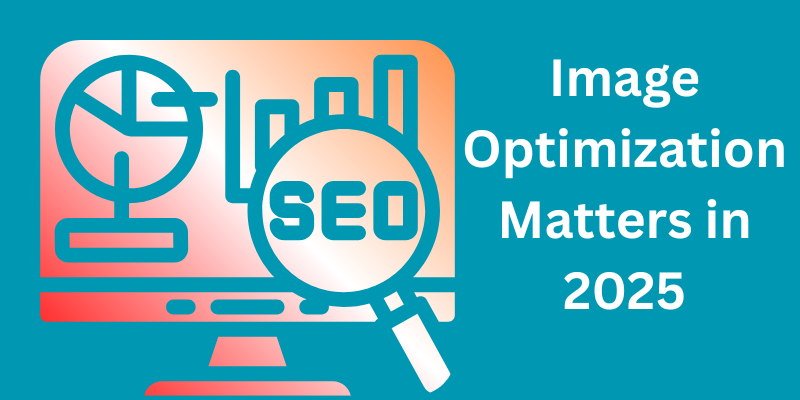SEO for Image Optimization: A Beginner’s Guide in 2025
Published: 12/May/2025
Images are more than just visuals. When optimized correctly, they help your blog rank better in search results. This guide will teach you how to master image optimization SEO in simple steps.

Why Image Optimization SEO Matters in 2025
Did you know that optimized images can be the difference between a fast-loading blog and one that loses readers in seconds? In 2025, image SEO isn’t optional; it’s essential. Whether you’re a blogger, online store owner, or content creator, optimizing your images is key to improving organic traffic and boosting your visibility on search engines.
Today’s users expect fast, clean, and engaging websites. And search engines reward that. From reducing page load time to helping your content appear in Google Image Search, proper image practices are now a critical part of any content strategy.
This beginner’s guide will show you practical, easy-to-use steps to optimize your visuals and get more natural growth from your content. You’ll discover how properly labeled, compressed, and placed images not only improve speed but also help your site climb the rankings. Ready to turn your pictures into powerful visibility tools? Let’s dive in.
What is image optimization SEO?
Optimizing images means improving your photos so they help your content appear higher in search engines. It’s not just about smaller file sizes. It also includes using the right names, tags, and formats.
By doing this, your site loads faster, ranks better, and gives a smooth experience to visitors. That helps build trust, keeps users around longer, and supports steady organic ranking.
Why Image Optimization Matters for Organic Ranking
Search engines love fast, user-friendly websites. Well-optimized images help with that. When your page loads faster, visitors stay longer. This tells Google your site is useful.
Here’s what optimized images do:
- Support natural traffic growth
- Improve site speed
- Reduce bounce rate
- Make your website more user-friendly
- Help with voice and visual search
Real-life example: If a blog uses high-quality visuals that load fast and have the right labels, it usually sees more visibility from Google Image Search.
Key Benefits of Image Optimization in SEO
Let’s break it down. Optimizing your images helps in many ways:
1. Faster Website Speed
Large visuals slow down your site. Compressing them helps your pages load quickly.
2. Higher Search Visibility
Search engines can’t see images, but they can read the file name, alt text, and caption. This helps your content appear in image search.
3. Better User Experience
Nobody likes slow websites. Small, high-quality images give a better experience.
4. Lower Bounce Rate
When your site loads fast and looks clean, visitors stay longer. That’s good for your search position.
5. Improved Mobile Experience
Scaled-down, compressed images adjust better on mobile screens.
SEO Picture Optimization Techniques
Want to get started? Here are steps you can use today:
1. Use Descriptive File Names
Instead of “IMG_1234.jpg,” name it “seo-guide-cover.jpg.”
2. Add Alt Text
Alt text describes your image. Example: Alt “Chart showing image optimization tips.”
3. Compress Images
Use free tools like TinyPNG or ImageCompressor to reduce image size.
4. Choose the Right Format
- JPG for photos
- PNG for transparent backgrounds
- WebP for fast loading
5. Resize Before Uploading
Don’t upload large photos and resize them later. Do it before.
6. Use Lazy Loading
This makes images load only when needed as the user scrolls.
7. Create Image Sitemaps
For image-heavy sites, sitemaps help Google find your visuals.
Image Optimization on One Page SEO
When writing a blog, don’t forget your visuals. Here’s how to do it on a single page:
- Use meaningful images
- Place visuals near related content
- Add keywords to file names and alt tags
- Keep image sizes small
- Add short captions
These small steps play a big role in overall search performance.
Image Compression in SEO: Tools You Can Use
Here are free tools for compressing pictures:
- TinyPNG—Great for PNG and JPG
- Compressor.io—Reduces size, keeps quality
- ImageOptim—Best for Mac
- Squoosh—Google’s simple, free tool
These tools help lower image size without harming quality. That means better speed and a smoother visit for your users. Small changes lead to big results.
Hiring an Image Optimization Service
If you have a large site or run an online store, consider using an image optimization service. These tools:
- Handle many images quickly
- Offer automatic features
- Improve mobile load speed
- Give detailed reports
Top services include:
- ShortPixel
- Kraken.io
- Cloudinary
An expert service saves time and ensures your visuals are always in top shape.
Image Optimization SEO for Beginners: Real-Life Tips
Here’s a quick checklist to follow:
- ✅ Name your files clearly
- ✅ Add helpful alt text
- ✅ Compress before upload
- ✅ Use WebP when possible
- ✅ Add simple captions
- ✅ Skip generic stock photos
- ✅ Place images near related text
How Image Optimization Boosts Organic Growth
When you optimize your visuals:
- Google better understands your content
- You show up in image search
- Your website loads faster
- Your bounce rate goes down
All of this supports your goal of getting better natural rankings and long-term success.
FAQs:
1. What is image optimization in SEO?
It means making your pictures faster and easier for search engines to understand.
2. Why is image optimization important for SEO?
It boosts site speed, improves user experience, and helps with visibility.
3. What tools can I use for image compression?
Use TinyPNG, Squoosh, ImageOptim, or Compressor.io.
4. Does image optimization affect search rankings?
Yes. Speed, image tags, and user experience are all part of SEO.
5. What’s the difference between resizing and full optimization?
Optimization includes naming, compressing, tagging, and resizing.
6. Do I need technical skills for image optimization?
No, anyone can start. A little practice is all it takes.
Final Thoughts
Image SEO isn’t just for tech experts. Anyone can do it, and it’s a great way to improve search traffic and speed.
Start using the tips in this guide. You’ll help your content stand out, load faster, and connect with more readers. Keep testing different strategies, and over time, your visuals will become key players in your search engine success.
Here are more blogs for your interest:
- How to perform a basic SEO audit using free tools?
- How to create content using AI writing tools for SEO?
- How to Use Meta Tags for Better Search Visibility in 2025





